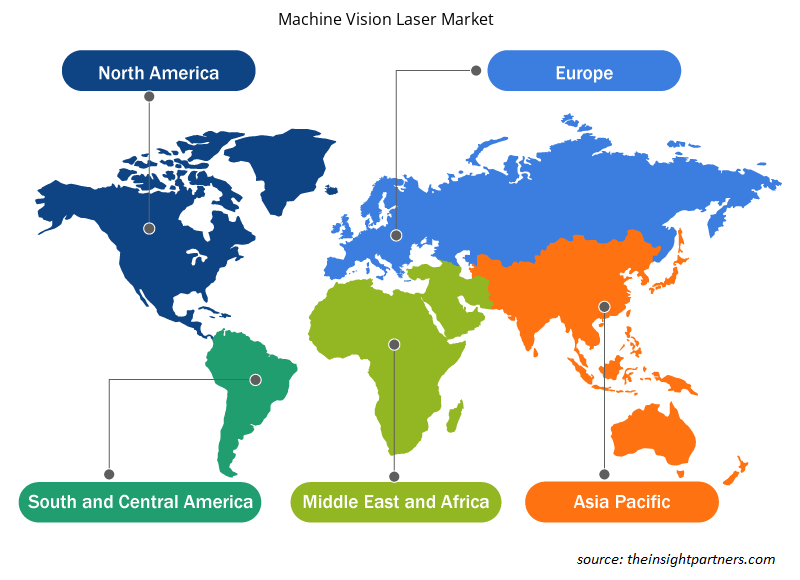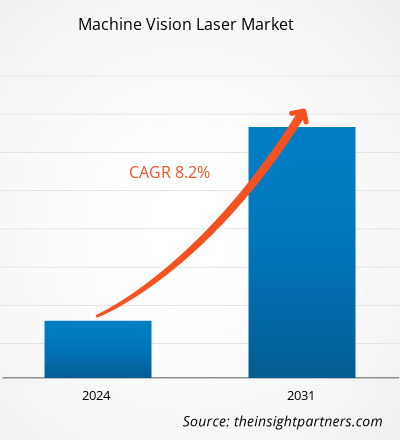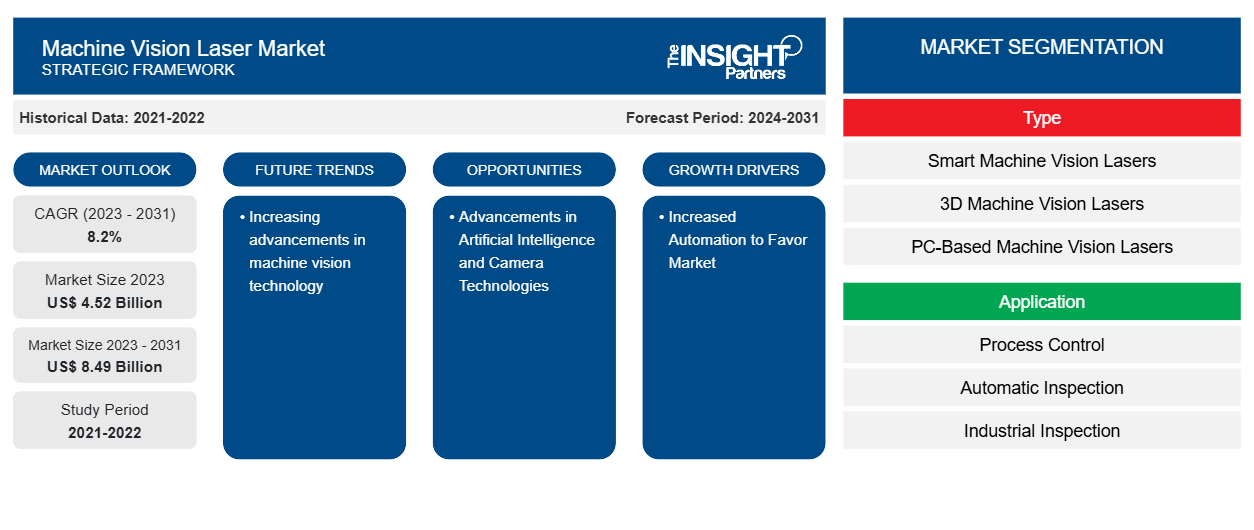全球机器视觉激光市场规模预计将从 2023 年的 45.2 亿美元增长到 2031 年的 84.9 亿美元;预计从 2024 年到 2031 年的复合年增长率为 8.2%。机器视觉技术的不断进步可能仍是机器视觉激光市场的关键趋势。
机器视觉激光市场分析
各个垂直行业对增强质量检测和自动化的需求不断增长,预计将推动市场增长。
机器视觉激光市场概览
机器视觉 (MV) 激光系统使用摄像机、数字信号处理和模拟数字转换,让计算机查看、检查和评估工作绩效。这些系统收集数据,随后将其发送到计算机进行处理并生成所需的输出。分辨率和灵敏度是 MV 系统中的两个关键参数。分辨率决定了系统区分事物的能力。同时,灵敏度是指机器在低光环境或人眼不可见的波长下识别物体或弱信号的能力。这些系统对于管理工作环境至关重要,包括工业应用中的过程控制、机器人引导和自动检查等功能。
定制此报告以满足您的需求
您可以免费定制任何报告,包括本报告的部分内容、国家级分析、Excel 数据包,以及为初创企业和大学提供优惠和折扣
-
获取此报告的关键市场趋势。这个免费样品将包括数据分析,从市场趋势到估计和预测。
机器视觉激光市场驱动因素和机遇
提高自动化程度有利于市场
自动化在各个行业越来越受欢迎,这得益于人们对提高效率和质量控制的渴望。这种趋势在制造业和物流业尤其普遍。自动化流程的部署导致对机器视觉系统(尤其是基于激光的技术)的需求增加,以改进这些自动化操作。在生产和物流中使用自动化有几个好处。一个关键优势是产品质量的控制和一致性更好。自动化系统通常比人工操作具有更低的可变性,从而可以更好地控制产品质量。
人工智能和相机技术的进步
人工智能 (AI) 和相机技术的进步极大地促进了机器视觉市场的增长和发展。这些改进提高了机器视觉系统的功能,使其在各种应用中更加精确和高效。机器视觉领域最显著的进步之一是人工智能和深度学习方法的使用日益增多。算法和深度学习方法使计算机能够从数据中学习并独立提高其性能,而无需人工干预。这导致了越来越复杂的机器视觉系统的诞生,这些系统可以以更高的精度和速度检测和分析图片或胶片。
机器视觉激光市场报告细分分析
有助于得出机器视觉激光市场分析类型、应用和最终用户的关键部分。
- 根据类型,市场分为智能机器视觉激光器、3D 机器视觉激光器和基于 PC 的机器视觉激光器。智能机器视觉激光器细分市场在 2023 年占据了更大的市场份额。
- 根据应用,市场分为过程控制、自动检测、工业检测等。自动检测激光器领域在 2023 年占据了更大的市场份额。
- 根据最终用户,市场分为汽车、电子和半导体、食品和饮料、制药、物流等。汽车行业在 2023 年占据了更大的市场份额。
机器视觉激光市场份额(按地区)分析
机器视觉激光市场报告的地理范围主要分为五个区域:北美、亚太地区、欧洲、中东和非洲以及南美/南美和中美。2023 年,北美主导了机器视觉激光市场。对自动化的不断增长的需求以及各行各业对先进成像技术的整合正在推动北美机器视觉激光市场的发展。此外,市场主要参与者对技术进步的关注预计将推动机器视觉激光市场的增长。这些进步包括独立于平台的软件、智能相机、3D 传感器和视觉控制器的开发。
机器视觉激光市场区域洞察
Insight Partners 的分析师已详尽解释了预测期内影响机器视觉激光市场的区域趋势和因素。本节还讨论了北美、欧洲、亚太地区、中东和非洲以及南美和中美洲的机器视觉激光市场细分和地理位置。

- 获取机器视觉激光市场的区域特定数据
机器视觉激光市场报告范围
| 报告属性 | 细节 |
|---|---|
| 2023 年的市场规模 | 45.2亿美元 |
| 2031 年市场规模 | 84.9 亿美元 |
| 全球复合年增长率(2023 - 2031) | 8.2% |
| 史料 | 2021-2022 |
| 预测期 | 2024-2031 |
| 涵盖的领域 |
按类型
|
| 覆盖地区和国家 |
北美
|
| 市场领导者和主要公司简介 |
|
市场参与者密度:了解其对商业动态的影响
机器视觉激光市场正在快速增长,这得益于终端用户需求的不断增长,而这些需求又源于消费者偏好的不断变化、技术进步以及对产品优势的认识不断提高等因素。随着需求的增加,企业正在扩大其产品范围,进行创新以满足消费者的需求,并利用新兴趋势,从而进一步推动市场增长。
市场参与者密度是指在特定市场或行业内运营的企业或公司的分布情况。它表明相对于给定市场空间的规模或总市场价值,有多少竞争对手(市场参与者)存在于该市场空间中。
在机器视觉激光市场运营的主要公司有:
- Cavitar 有限公司
- 康耐视公司
- 激光元件有限公司
- 激光治疗仪
- 基恩士公司
- 普罗菲尼克斯
免责声明:上面列出的公司没有按照任何特定顺序排列。

- 了解机器视觉激光市场主要参与者概况
机器视觉激光市场新闻和最新发展
机器视觉激光市场通过收集一手和二手研究后的定性和定量数据进行评估,其中包括重要的公司出版物、协会数据和数据库。以下是市场发展情况的列表:
- 2023 年 10 月,基恩士公司推出了 VS 系列,这是一系列新的智能相机视觉系统。该系统设计为用户友好型,不需要控制面板或软件来检查 IP 地址和连接。它的防护等级为 IP67,并配备了多项增强其功能的功能。这些功能包括内置激光指示器、四个用于灵活安装配置的安装孔以及对以太网供电的支持,允许使用单根以太网电缆为相机和灯供电。
(来源:Keyence Corporation,新闻稿,2023 年)
机器视觉激光市场报告覆盖范围和交付成果
“机器视觉激光市场规模和预测(2021-2031)”报告对以下领域进行了详细的市场分析:
- 范围内所有主要细分市场的全球、区域和国家层面的市场规模和预测
- 市场动态,如驱动因素、限制因素和关键机遇
- 未来的主要趋势
- 详细的 PEST/波特五力分析和 SWOT 分析
- 全球和区域市场分析涵盖关键市场趋势、主要参与者、法规和最新市场发展
- 行业格局和竞争分析,涵盖市场集中度、热点图分析、知名参与者和最新发展
- 详细的公司简介
- 历史分析(2 年)、基准年、预测(7 年)及复合年增长率
- PEST和SWOT分析
- 市场规模、价值/数量 - 全球、区域、国家
- 行业和竞争格局
- Excel 数据集
近期报告
相关报告
客户评价
购买理由
- 明智的决策
- 了解市场动态
- 竞争分析
- 客户洞察
- 市场预测
- 风险规避
- 战略规划
- 投资论证
- 识别新兴市场
- 优化营销策略
- 提升运营效率
- 顺应监管趋势























 获取免费样品 - 机器视觉激光市场
获取免费样品 - 机器视觉激光市场